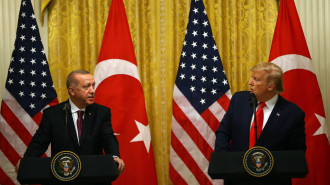The Syrian private sector's Faustian bargain
On the morning of March 8, 1963, Baathist, Nasserist, Arab nationalist and independent officers staged a military coup in Damascus. Their slogan was Arab unity, justice, and socialism, as they declared their intention to eliminate the "exploiting" class.
As with similar coups in the "developing world", military officers took power and pushed through a number of socio-economic reforms.
The new military authorities banished the old political classes. In Syria, the military junta removed the government of Khaled al-Azm, dissolved the elected parliament and restricted freedom of assembly and the freedom of expression.
The junta dissolved political parties, closed down newspapers, disbanded trade unions, and banned social and political associations, concentrating political power in the hands of the putschists. But soon enough, rivalries and conflict emerged in the ranks of the military junta, until power ended up exclusively in the hands of the Baathist faction.
The 1960s
In 1964 and 1965, the Baathist military regime confiscated the property of major landowners, distributing part of the land to peasants, and keeping hold of the rest as state property. The regime nationalised the pharmaceutical industry and scores of businesses, banks, and insurance companies, all while interfering in domestic trade.
| The private sector declined until it represented no more than 25 percent of industrial output in the early 1970s. |
The entire education sector was nationalised.
Strict capital controls were imposed, with restrictions on monetary transfers.
The civil servant class expanded dramatically, as large numbers of people from the countryside and poor urban classes joined the rising classes.
The role of the private sector declined until it represented no more than 25 percent of industrial output in the early 1970s, comprising primarily artisan workshops.
Very small, small and medium private enterprises dominated all sectors of the national economy.
As a result of the new regime's measures, traditional social elites and the families of former major entrepreneurs were stripped of their economic and political power, as well as their social standing. They lost their erstwhile influence.
People like Khaled al-Azm, whose memoirs would be banned in Syria, disappeared from the scene.
The al-Youssuf, al-Atassi, al-Khoury, al-Quwatli, al-Haffar, al-Qabbani, al-Zaim, al-Barazi, al-Shishakli, al-Najar, and many, many other families disappeared from view.
They could no longer be seen travelling in luxury cars as in the past, and they had little of their previous influence on the state.
The new ruling class, especially high ranking officers in the army and security forces, Baath leaders, the leaders of workers' and peasants' organisations, and other state organisations and institutions, became the most powerful in the land.
Many of them now drove in luxury cars, and yesterday's elites and ordinary people sought to cajole them to secure a favour, a deal, to gain employment or request any other service.
Political, economic, and even social power became concentrated to a large extent in the hands of the oversized state. Indeed, those who controlled the state steered the state in any direction they wanted, and controlled society in all its aspects.
The former ruling coalition, which consisted of feudal classes, emerging capitalists, and traditional families, was replaced by a new alliance, which now consisted of the army, the so-called revolutionary intelligentsia, rural peasants, and the poor urban classes.
This is the formula that Akram Hourani described in detail, Hourani being one of the foremost political figures in Syria from the mid-1940s to the mid-1960s.
The 1970s
Certain segments of the urban class welcomed the removal of the radical Salah Jadid from power. Jadid was succeeded in power by the more pragmatic then-Defence Minister Hafez Assad in a military coup on November 16, 1970. The urban bourgeoisie quickly put up banners in the markets in Damascus, Aleppo, Homs, and Hama, welcoming and praising Assad.
Assad initiated a new economic policy that was more open to the private sector, and did not implement any new socialist measures. Instead, Assad pursued a policy of so-called economic pluralism, and opened a backdoor to limited investment by the private sector.
After the war of October 1973, Assad issued legislation allowing the establishment of tourist companies and hotels as part of public-private partnerships. The assistance Syria received from some oil-rich Arab countries, to the tune of $1.5 billion annually, gave the government the ability to expand its spending, develop infrastructure, or build factories and establish companies. All this created a larger space for the private sector to operate and the private sector, after nearly a decade of nationalization and restrictions, thrived as it gained momentum.
Thus, beginning in the 1970s, business people began to rise once again in prominence, including names such as al-Attar, Taqla, al-Shallah, and many others. Partnerships between government and military figures and the new business sector began to emerge.
| In the 1990s Assad did not implement reforms to complement the investment friendly environment, so investment declined. |
While those officials had controlled the decisions related to approving profit-generating businesses, they could not engage themselves in business directly. Therefore, they went into partnerships with private-sector business people, sharing the profits.
Since the 1970s, smuggling began to grow as well. The import of many goods was banned, giving rise to specialized smuggling gangs with affiliations to the ruling clique. As a result, many amassed large fortunes by smuggling cigarettes, appliances, hard currency, precious metals, and so on.
The 1980s
Syria faced a stifling economic crisis that forced Assad to allow the private sector a wider role in the economy. The government further loosened its grip over the sectors it use to monopolize and encourage investments in tourism and agriculture, in addition to joint public – private investment in which the private sector provides the capital. These policies caused the enrichment of the state’s partners, who were already close to the centres of power. Thereafter, Syria overcame the economic crisis due to an increase in oil production from newly discovered fields and later the assistance it received as a result of taking part in the international coalition to drive Saddam Hussein out of Kuwait, in addition to implementing new policies that encouraged agriculture.
The 1990s
With the collapse of the friendly Eastern Bloc and the start of negotiations in Madrid between the Arab countries and Israel, Syrian authorities took a further step to open the door for the private sector.
In 1991, the Investment Promotion Bill number 10 was legislated, which resulted in a wave of investments specifically in manufacturing and transport. A larger number of businessmen started appearing on the Syrian scene alongside the growth in business groups owned by sons of Syrian officials. However, Assad in the 1990s did not implement any reforms to complement the investment friendly environment he was creating, so investment also declined. After Syria had overcome its economic crisis, Assad felt that he was less in need of being open onto the private sector, fearing the growth of its power, therefore private investment declined, causing a depression.
There was another motive for Assad senior to postpone measures that would make the Syrian economy more open. In addition to his severe illness, the father wanted to delay the implementation of open economic policies for his son Bashar, who was being groomed to take power after his father, in order for the policies to be considered an achievement for the son once implemented and help garner wider acceptability for the inheritance of power. Assad senior died on 10 June 2000 and power was handed over to Bashar as planned.
The transfer of power accelerated the pace of economic openness and ensured the return of capital to Syria. During the first decade of the 21st century, the state gave up most of its economic monopolies and for the first time, opened the financial sector, such as banks and insurance, to private investment, creating a financial market. Further, a free trade agreement was signed with Turkey, after Syria became part of the Greater Arab Free Trade Area (GAFTA) in 1997.
Legislative reforms were also made in the leasing market and agriculture, and the private sector was given access to the educational, real-estate, media and advertising sectors among others. In this period, the relatives of officials in the state and their business partners were given the largest piece of the investment pie, and by 2010, the business sector accounted for approximately 70 percent of gross domestic product.
During this period, state power was the catalyst through which the ruling military-political class amassed its private wealth and ensured its economic as well as its political hold of the country. After the policies of the 1960s, the economy was ring-fenced by government institutions with government gatekeepers controlling economic activity and misusing their power for their personal gain.
The Assad regime made sure it kept the private business sector under its firm control since the 1970s, utilizing its bureaucracy as a tool of control. Further, the regime established economic security courts to act as its strike force against businessmen who did not conform to the will of the regime or to those who strayed from the policies laid out by the regime. These courts targeted businessmen who had committed no wrong while ignoring the great violations committed by the regime-affiliated capitalists.
| The rentier economy developed through the state or through state sponsorship and could not survive without state support. |
The regime also worked to establish a strong private sector composed of relatives of officials and businessmen close to them, which would become the largest and most influential part of the private sector. Here a handful of names came to prominence, such as Rami Makhlouf and his brothers, the Riyadh brother, Dulhimma Shalish, Kamal al-Assad and a number of other Assads, Ghassan Mehenna, the Tlass family and others.
However this rentier economy that developed either directly through the state or through state sponsorship could not survive without state support, unlike the other productive capitalist classes that existed in Syria prior to 1963. The latter classes achieved their wealth through production, competition and an aversion to lavish spending.
Alongside this group of state-connected businessmen, another business sector composed of businessmen who were close to the people in power and relied on them to expand their business activities, however their reliance on power decreased over time. Names such as al-Nahhas, al-Shallah, al-Attar and others fall into this category, however this group soon started complaining of unfair competition by the first group who always had the state of their side.
However, despite those two groups, another group of Syrian businessmen developed, especially in industry, who relied on their skills and patience to achieve their success, through which they revived the spirit of the skilled Syrian businessmen, which had been stifled by the Baath regime for five decades.
Finally
The Syrian economy came full circle and capitalism returned to Syria. Capitalism, which the Baath coup claimed it wanted to eradicate. However, it came back as a new class that reflects the alliance between the totalitarian political regime that relies on the army, and a capitalist class that in large part belongs to the ruling political class. Thus, creating a ruling financial, political and military clique.
This is an edited translation from our Arabic edition.







 Follow the Middle East's top stories in English at The New Arab on Google News
Follow the Middle East's top stories in English at The New Arab on Google News


